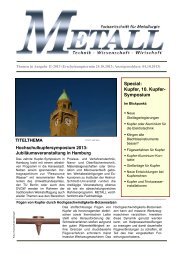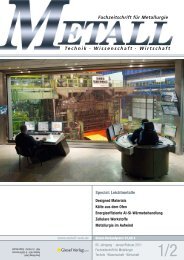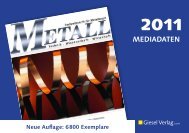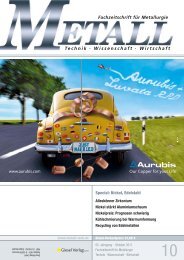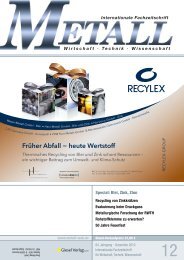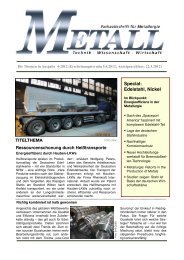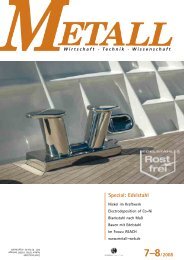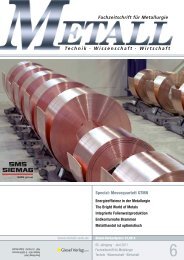Verlassen Sie sich darauf: Geballte Metall-Kompetenz - Metall-web.de
Verlassen Sie sich darauf: Geballte Metall-Kompetenz - Metall-web.de
Verlassen Sie sich darauf: Geballte Metall-Kompetenz - Metall-web.de
Sie wollen auch ein ePaper? Erhöhen Sie die Reichweite Ihrer Titel.
YUMPU macht aus Druck-PDFs automatisch weboptimierte ePaper, die Google liebt.
METALL VOR ORT<br />
(> 5 m/s MRV) at a collision mo<strong>de</strong>l<br />
(> 9 m/s up to 14 m/s MRV) resulting in<br />
processing times ranging from seconds<br />
to minutes to a few hours at maximum<br />
resulting in low contamination levels<br />
in respect of the processing tools. As<br />
for the oxygen pick-up, the equipment<br />
must provi<strong>de</strong> a process un<strong>de</strong>r completely<br />
protected conditions (inert gas<br />
or vacuum) which must cover charging<br />
(loading), processing and discharging<br />
(unloading).<br />
Potential passivation after discharging<br />
can be an important issue as well and<br />
the entire process cannot exhibit any<br />
<strong>de</strong>ad-zones. This is what Zoz GmbH is<br />
providing and applying.<br />
Third and fourth secret:<br />
HEM and HRS<br />
One interesting example for the use of<br />
the high energy milling (HEM) un<strong>de</strong>r<br />
the protection of inert gas was given by<br />
Prof. Cai Xiaolan, University of Science<br />
and Technology, Kunming, Yunnan,<br />
with the preparation of Zinc-flakes by<br />
High Energy Milling.<br />
The increase of strength was also<br />
topic of the presentation of Tatsuya<br />
Sekiguchi, Ritsumeikan University. In<br />
this investigation pure titanium pow<strong>de</strong>r<br />
and a Ti-6Al-4V alloy pow<strong>de</strong>r are<br />
treated by mechanical milling (MM),<br />
which is one of the severe plastic <strong>de</strong>formation<br />
(SPD) processes. The MM<br />
process enables the production of a<br />
nano grain microstructure very easily<br />
Discussion during the poster session<br />
216<br />
and has been applied to many pow<strong>de</strong>r<br />
materials. They are then sintered<br />
by hot roll sintering (HRS). The MM<br />
pow<strong>de</strong>rs have a nano grain structure<br />
with grain size of about 50 nm at the<br />
surface region and have a work har<strong>de</strong>ned<br />
microstructure in the core region<br />
of the pow<strong>de</strong>r. The HRS compacts have<br />
a harmonic microstructure that consists<br />
of a nano grain structure with a<br />
grain size of 200 to 500 nm and a coarse<br />
martensite structure. The pure titanium<br />
and Ti-6Al-4V HRS compacts indicate<br />
superior mechanical properties.<br />
The HRS compacts indicate a good<br />
elongation compared to conventional<br />
heavily <strong>de</strong>formed materials. “The HRS<br />
process is very effective to the improvement<br />
of mechanical properties in the<br />
pure titanium and Ti-6Al-4V alloy.”,<br />
the speaker conclu<strong>de</strong>d.<br />
Secret No. 5: Very fine pow<strong>de</strong>rs<br />
Takeshi Fukuda, Fukuda Metal Foil &<br />
Pow<strong>de</strong>r Co., Japan, spoke about diameter<br />
control of stamped pow<strong>de</strong>r. He<br />
said that his company is producing a<br />
lot of different metal pow<strong>de</strong>rs for several<br />
applications, for example for the<br />
automotive industry and engineering.<br />
The speaker showed interesting examples<br />
of sintering parts, ma<strong>de</strong> out of copper,<br />
bronze – combined with diamond<br />
or carbon. In such cases bronze pow<strong>de</strong>r<br />
is acting as a bin<strong>de</strong>r. In a vi<strong>de</strong>o the<br />
speaker showed how fine pow<strong>de</strong>rs are<br />
floating in a stamp mill. He discussed<br />
methods for achieving a very fine distribution.<br />
Prof. Nobuhiro Tsuji, Kyoto University,<br />
Japan, spoke about the unique<br />
microstructures and mechanical<br />
properties of nanonstructured metals<br />
fabricated by severe plastic <strong>de</strong>formation.<br />
Ultrafine grains or nanocrystals<br />
are much smaller than 1 μm, that<br />
means the volume fraction of grain<br />
boundaries quickly increases. (For<br />
comparison: the conventional grain<br />
size ranges from 1 to 100 μm). The<br />
severe plastic <strong>de</strong>formation (SPD) was<br />
carried out as a rolling process (ε > 4),<br />
called ARB (accumulated rolling<br />
bonding), <strong>de</strong>veloped by the author.<br />
Several materials were examined, for<br />
example carbon steels, stainless steels,<br />
Al-alloys, OFHC-Cu, Cu-Co-P and<br />
some others. The <strong>de</strong>termination of<br />
the microstructure was carried out<br />
by an TEM Kikuchi lines misorientation<br />
analysis. It shows, the most of<br />
the boundaries were high angle grain<br />
boundaries, but in a very low grain<br />
size. The mechanical properties are<br />
impressive: For aluminium a tremendous<br />
strength was achieved.<br />
Secret No. 6: Nanoclusters<br />
Prof. Dr. Brian Wirth, University of<br />
California Berkeley, USA, spoke about<br />
atomic scale investigations of Y-Ti-Onanoclusters<br />
in nanostructured ferritic<br />
alloys. He told the audience that<br />
nanostructured ferritic alloys (NFAs)<br />
are characterized by very high tensile<br />
and creep strength at temperatures<br />
of 650 °C and above, and remarkable<br />
resistance to neutron irradiation effects.<br />
These properties result from a<br />
very high number of <strong>de</strong>nsity dispersions<br />
of nm-scale Y-Ti-O rich features<br />
(NFs) that precipitate homogeneously<br />
at high consolidation temperatures<br />
from mechanically alloyed Fe-Cr-Ti-<br />
Y 2 O 3 pow<strong>de</strong>rs. NFs form rapidly at a<br />
number of <strong>de</strong>nsities, sizes and characters<br />
(compositions and structures) that<br />
are primarily dictated by the processing<br />
temperature history and alloy composition.<br />
However, the precise natures<br />
of various NFs are not yet well un<strong>de</strong>rstood,<br />
and they appear to range from<br />
coherent solute enriched GP-type<br />
zones to near stoichiometric complex<br />
5/2009 | 63. Jahrgang | METALL




